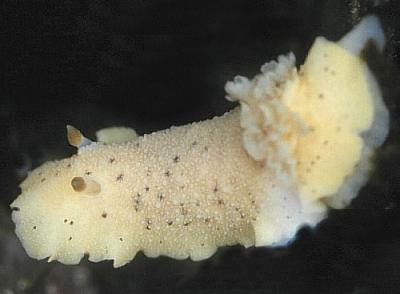
Geitodoris heathi
(Macfarland, 1905)
Order: NUDIBRANCHIA
Suborder: DORIDINA
Superfamily: EUDORIDOIDEA
Family: Dorididae
DISTRIBUTION
Alaska to Baja California.
PHOTO
Cape Arago, Oregon, March, 1986. Photo: Jeff Goddard.
Very variably coloured species growing to about 45mm. Often has scattered black specks but they can be aggregated into a central patch just in front of the gills.
See Sandra Millen's message for a discussion on this and similar looking species.
See Jeff Goddard's message about possible mimicry.
Reference:
• MacFarland, F.M. (1905). A preliminary account of the Dorididae of the Monterey Bay, California. Proceedings of the Biological Society of Washington, 18: 35-54
Rudman, W.B., 2000 (October 22) Geitodoris heathi (Macfarland, 1905). [In] Sea Slug Forum. Australian Museum, Sydney. Available from http://www.seaslugforum.net/find/geitheat
Related messages
White and yellow variation of Geitodoris heathi
September 2, 2008
From: John Yasaki
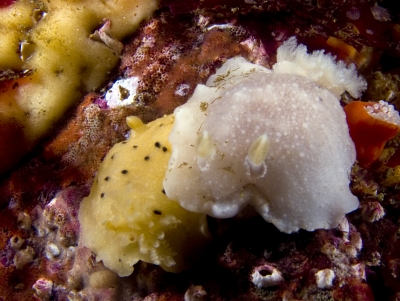
Concerning message #20264:
Just to add to the mix, a white, and a speckled yellow Geitodoris heathi, apparently mating (or nearly mating.) From Monterey Bay, California.
Locality: Pacific Grove, 75 fsw, California, USA, Pacific Ocean (Monterey Bay), 09 August 2008, Rocky reef. Length: approx 1.5". Photographer: John Yasaki.
John Yasaki
jyasaki@chabotcollege.edu
Yasaki, J. K., 2008 (Sep 2) White and yellow variation of Geitodoris heathi. [Message in] Sea Slug Forum. Australian Museum, Sydney. Available from http://www.seaslugforum.net/find/21807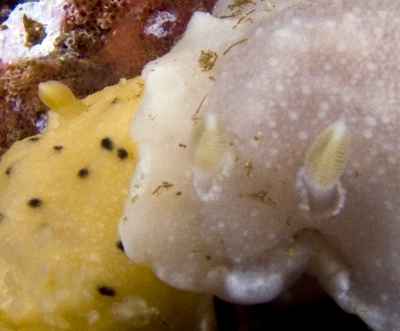
Hi John,
I wish I could confirm for sure that these are indeed Geitodoris heathi but without a better look at the gill, we will have to take your word for it.
This species is quite variable in color, but I have never seen one this pale. This is a great example of just how variable colors can be in nudibranchsThanks for sharing this,
Dave Behrens
White variation of Geitodoris heathi
July 28, 2007
From: Robert Lee
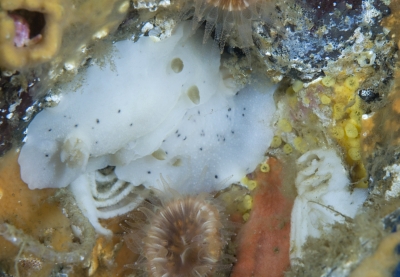
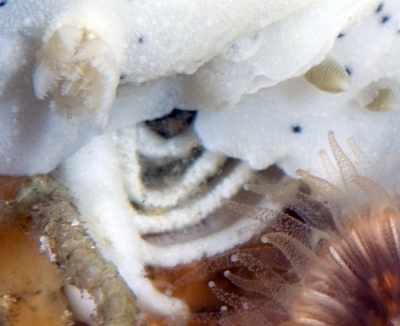
Hi Bill,
I've seen the past discussion regarding the white dorids on the west coast and thought I would send this photo which was taken in Carmel last weekend. Jeff Goddard has ID'd these critters as Geitodoris heathi. Perhaps this adds another piece to the puzzle.
Locality: Point Lobos, Carmel, 18m, CA, USA, Pacific Ocean, 15 July 2007, rocky reef. Length: 80-100mm. Photographer: Robert Lee.
-Rob
robert.h.lee@oracle.com
Lee, R. H., 2007 (Jul 28) White variation of Geitodoris heathi. [Message in] Sea Slug Forum. Australian Museum, Sydney. Available from http://www.seaslugforum.net/find/20264
Hi Robert,
These white dorids drive me crazy. The coin toss here is between Geitodoris and Doris montereyensis. I tend to agree with Jeff that it is the former based on the texture of the notal surface.
Thanks for sharing,
Dave Behrens
Geitodoris heathi from Monterey, California
April 27, 2006
From: Clinton Bauder

Hi Bill,
As promised [message #16296 ] here are some images of "typical" specimens of Geitodoris heathi taken by my friend Mike Jimenez.
Locality: Shale beds, Monterey, 18 meters, CA, USA, Pacific, 8 April 2006, Shale reef. Length: 40-60 mm. Photographer: Michael Jimenez.
Clinton
gecko1@apple.com
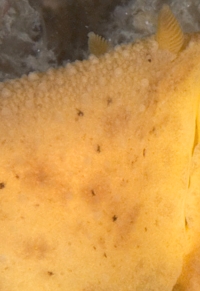

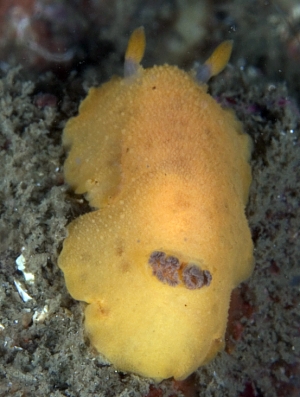
Hi Clinton,
No mistaking these. You are correct, this is the typical colouration. Dirty brown looking gill, created by many tiny brown specks on a white background. Depending on the individual, the notum also has a few brown spots, and a scattering of light brown patches created by an aggregation of tiny brown specks.
These photos also show, quite well in fact, the shape and variation in size of the dorsal tubercles, which make them distinct from other yellow dorids on the coastline.
Thanks, nice shots,
Dave Behrens
Geitodoris heathi from the Channel Ids, California
August 8, 2003
From: Bruce Wight

Dear Bill,
Johanna and I saw lots of great natural behavior on last weekends dive trip out to San Miguel Island [Channel Islands National Park, California - July 2003]. Here is one of a series of messages showing some images I took during the two day trip.
This is specimen Dave Behren's has identified for me as Geitodoris heathi.
As always, thanks for your help and hope you enjoy the images,
Bruce Wight
bwproductions@earthlink.net
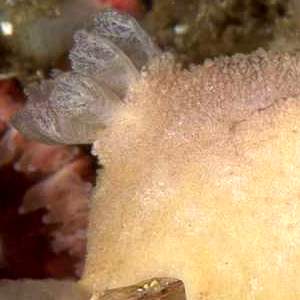
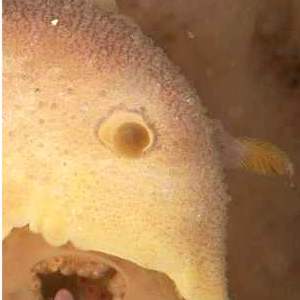
Thanks Bruce,
Bill Rudman
Re: Geitodoris heathi? from California
August 14, 2002
From: Dave Behrens
Bill:
Clinton's animals are Geitodoris heathi for sure. Good example showing fine dark speckling on the gills.
Dave Behrens
dave@seachallengers.com
Behrens, D., 2002 (Aug 14) Re: Geitodoris heathi? from California. [Message in] Sea Slug Forum. Australian Museum, Sydney. Available from http://www.seaslugforum.net/find/7762Thanks Dave,
Bill Rudman
Geitodoris heathi? from California
August 10, 2002
From: Clinton Bauder
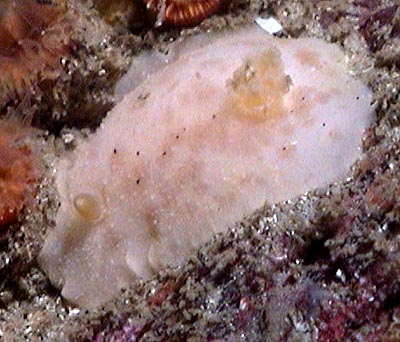
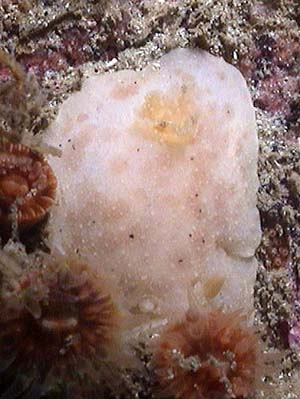
Hi Bill,
Found this guy at about 15m at Hopkins Deep Reef in Monterey, California [December, 2001]. It's about 30mm in length. At first I thought it was Anisodoris lentiginosa but upon looking at it further I think it's more likely Geitodoris heathi. Even so, it's clear to me that my ability to ID these whiteish dorids is limited. I settled on G. heathi in this case because of the spots on the gills and the relatively short, straight rhinophores but I'd love to get a second opinion.
Clinton
gecko1@apple.com
Bauder,C., 2002 (Aug 10) Geitodoris heathi? from California. [Message in] Sea Slug Forum. Australian Museum, Sydney. Available from http://www.seaslugforum.net/find/5851Dear Clinton,
I'm afraid this one got lost in my backlog. I would appreciate some feedback from local experts on this, and the animal in your earlier message
Best wishes,
Bill Rudman.
Geitodoris heathi? from California
June 27, 2002
From: Clinton Bauder


Hi Bill,
Saw what I think was Geitodoris heathi munching on an unknown sponge on a deep pinnacle outside of Point Lobos, California, recently. Depth was about 50M. The slug is maybe 50mm in length.
Clinton
gecko1@apple.com
Bauder, C., 2002 (Jun 27) Geitodoris heathi? from California. [Message in] Sea Slug Forum. Australian Museum, Sydney. Available from http://www.seaslugforum.net/find/7312Thanks Clinton,
From past experience I think I will wait for some Californian expert to comment on the identity of this animal. It looks too much like "sea lemon" territory - and I have been lost there before.
Cheers,
Bill
Sea Lemon mimicry complex?
October 23, 2000
From: Jeff Goddard

Hi Bill,
The Forum has been on the subject of the so called Sea Lemons lately, and we have seen how closely some of these species resemble one another externally (Archidoris montereyensis and Anisodoris nobilis especially are confused for one another). I would like to suggest that Archidoris montereyensis, Anisodoris nobilis, Geitodoris heathi, Anisodoris lentiginosa, the yellow form of Archidoris odhneri, Aldisa cooperi, and yellow forms of the keyhole limpet Fissurellidea bimaculata are part of a mimicry complex which confers protection from visual predators, especially when an individual is off its sponge prey and out in the open. On their prey, most of these species are quite cryptically colored. While the resemblance between most of these species is pretty superficial, it may be enough to ward off a foraging fish already familiar with the noxious qualities of one of them.
Excepting the yellow form of Archidoris odhneri, which I don't have a photo of, I have enclosed photos of the species mentioned above which are not yet pictured on the Forum.
[PHOTOS: Specimens were all collected at Cape Arago, Oregon: UPPER RIGHT: Geitodoris heathi, March 1986. LOWER LEFT: Fissurellidea bimaculata November 1986. LOWER RIGHT: Aldisa cooperi, June 1981]
Best wishes,
Jeff
goddard@lifesci.ucsb.edu


Thanks Jeff,
There have been some interesting articles written on mimicry. What we need to be careful of is separating the phenomenon of 'looking alike' from the biological process we call mimicry - a process in which one or more species evolve to look like another species (the model). The biggest hurdle to identifying examples of mimicry, let alone studying it, is to find the predator - prey relationships which drive the evolutionary processes of selection needed to bring about similarities in shape and colour pattern. Unless they can be identified it is very difficult to determine which examples of 'looking alike' are the result of chance, and which are the result of evolutionary selection.
Thanks again for the interesting photos and for raising this interesting idea.
Best wishes
Bill Rudman.
